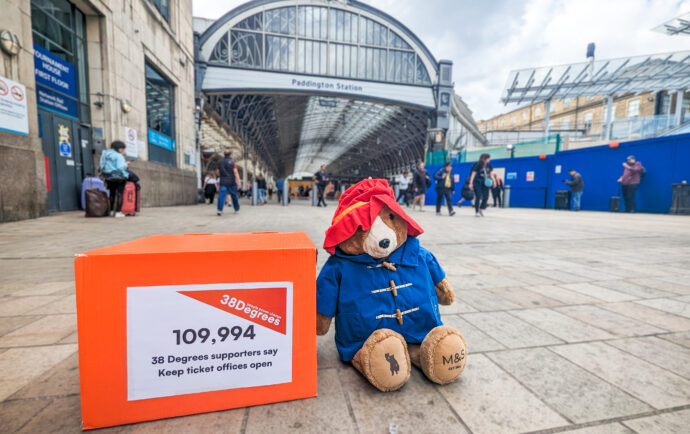
Sep 15th, 2011
Badger cull – DEFRA’S Chief Vet Responds
By marie

On Monday, we started posting up questions for the government’s Chief Vet, Nigel Gibbens, about the government’s plans to kill badgers next year.
Professor Gibbens first got involved in the 38 Degrees debate by commenting on our blog. Then we asked if he would like to answer 38 Degrees members questions about the plans.
By the deadine of Tuesday 13th at 5pm, more than a hundred people had posted questions. The 38 Degrees office team read all the questions and tried to choose those which summed up the key issues and got to the heart of the debate. We sent these to DEFRA (the government department responsible for the cull), and Professor Gibbens answers are below.
“Thank you for giving me the opportunity to reply to some of the questions of 38 Degrees petitioners. Culling badgers is not an easy decision to make, and I hope my answers show the facts that Ministers have based their proposals on.” Prof Nigel Gibbens
QUESTION: Defra’s cost benefit calculations on the results of a badger cull assume that shooting free running badgers will have the same results as trapping and then shooting, as done in the randomised cull. The members of the Independent Scientific Group have said that this assumption is unjustified. Does Defra have evidence to support its assumption? David Sawers
CHIEF VET’S ANSWER: “There’s no evidence to suggest that the results would be any different. Reducing disease transmission requires a reduction in the number of infected badgers that come into contact with cattle. We would also require reasonable measures to reduce the risk of badgers spreading the disease outside the culled area.
The two pilot culls are proposed to find out whether the controlled shooting method would be as effective in reducing the badger population and as humane as we intend it to be.”
QUESTION: Will you be testing all the badgers slaughtered in this proposed culling for bovine TB? Derekgb
CHIEF VET’S ANSWER: “No, because we already have evidence about how widespread bovine TB is in badgers in certain areas of the country.”
QUESTION: Why have all( bar one) of the UK wide field trials of an injectable badger vaccine, and further research into an oral vaccine (currently already being trialled in Ireland) been suspended by the current Government? Sarah
CHIEF VET’S ANSWER: “Research into an oral vaccine has not been suspended. The government plans to spend at least £7.4m on research into an oral vaccine for badgers over four years, and it’s still our ultimate goal – but we can’t be sure when or if it will ever be available and action is needed now if the spread of TB is to be halted. On the first part of the question, the Badger Vaccine Deployment Project was planned for six different areas to look at the practicalities of using an injectable vaccine, but we can get enough information about that from the one area where that project is now taking place.”
QUESTION: Why are the general public not being made aware that – in the previous 10 year random badger culling trial – approx 7 out of every 8 badgers shot were perfectly healthy? Perhaps the head DEFRA vet can dispel these myths for what they are and confirm that only in very limited cases can a proper expert identify a badger with bTB. Steve Hawkes
CHIEF VET’S ANSWER: “The evidence from the Randomised Badger Culling Trial (RBCT) showed that there was a substantial proportion of badgers infected with TB in problem areas. During the RBCT, an average of 16% of badgers were found to be infected. However this is likely to be an underestimate of the true figure, as TB infection is easily missed unless it is very advanced and detailed post-mortems during part of the RBCT showed TB infection was almost twice as high.”
QUESTION: What is Defra’s plan B if the cull fails to achieve its target? Michael Griffiths
CHIEF VET’S ANSWER : “We’re confident that controlled badger culling carried out in the correct way would be effective in reducing TB in cattle. We have a comprehensive programme to eradicate bovine TB, and badger culling is only one part of it. Other measures address cattle-to-cattle transmission through routine testing, pre-movement testing, movement restrictions and slaughter of infected cattle, as well as biosecurity measures. But we will never be able to eradicate TB in cattle without addressing its presence in badgers.”
QUESTION: Does the Chef Vet really think that randomly licensed farmers of varying ability shooting at free running badgers at night are realistically going to get a ‘clean’ and humane shot every time? AdrianS
CHIEF VET’S ANSWER: “Our proposal sets out strict criteria that applicants for a licence to cull badgers would have to meet to ensure culling is carried out safely, effectively and humanely. Those carrying out a cull would be required to have relevant training and competence including attendance at a Government-approved course and assessment.”
QUESTION: How are they going to measure with any degree of accuracy, the population of badgers in the target cull areas so that the required 70% killed can be achieved? Will this methodology be used in every single cull area that is licensed? Pauline Kidner
CHIEF VET’S ANSWER: “Questions answered together. Natural England would estimate the badger population in an area based on information provided by the applicants and other evidence. Natural England would then set the minimum number of badgers that must be removed at a level that should reduce the estimated badger population in the area by at least 70%. All badger carcases would be recorded so Natural England would know how many badgers had been culled.”
QUESTION: Monitoring – How will they mitigate the welfare aspect of shooting when the wounded badgers are likely to go underground in their sets? Pauline Kidner
CHIEF VET’S ANSWER: “Controlled shooting would be piloted in two areas to test our assumptions about humaneness. To ensure humaneness, operators would be required to follow best practice guidelines, undertake training and testing, and there would be careful monitoring via field observations and post mortems. This should minimise the likelihood of wounding but the Best Practice Guidance for people who would carry out a cull is designed to avoid the risk of a wounded badger retreating back into the sett and thus ensure that it can be killed.”
QUESTION: How will they be able to monitor the impact of culling when it is to be carried out alongside new bio security measures, improved cattle testing and better cattle controls? Pauline Kidner
CHIEF VET’S ANSWER“The scientific evidence from the Randomised Badger Culling Trial has already shown that culling can reduce bovine TB incidence in cattle if done in a certain way. If culling is introduced it will not be as a scientifically controlled trial but a practical disease control measure. We would continue monitoring incidences of TB nationally including in areas where culling is taking place. We see culling as part of a package of measures which together will help eradicate the disease in cattle.”
QUESTION: If they abandon the trial as suggested by the Minister if the pilot ‘does not go well’, whatwill they do to mitigate against the perturbation that the culling will have already started? Pauline Kidner
CHIEF VET’S ANSWER: “Culling in the pilot areas would need to take place for at least four years. If controlled shooting was found not to be effective or humane, culling in the pilot areas would need to be completed using cage trapping and shooting.”
QUESTION: I know organic dairy farms who have closed herds, don’t allow ‘low grazing’, have badgers on their land but no cases of BTB. What is the incidence of BTB in large herds that are kept in sheds 24/7 365 days a year? Charliemasonfz
CHIEF VET’S ANSWER: “We don’t break down data on TB incidence between different types of farming systems, but there is no reason to think that organic farming methods reduce the risk of BTB. Given what we know about how TB is spread, operating a really closed herd (which does not introduce any cattle from outside the herd) and effectively preventing contact between cattle and infected badgers (or any material from them such as faeces ) would ensure that herds are not infected.”
QUESTION: Is it true that most of the transmission of BTB is from cattle to cattle? Where is the scientific evidence that badgers pass on TB to cattle? Guest
CHIEF VET’S ANSWER: “The Randomised Badger Culling Trial carried out by the Independent Scientific Group on Cattle TB demonstrated conclusively that badgers contribute significantly to bovine TB in cattle. The exact number of incidents caused by badgers or cattle is not known but various groups have estimated the badger contribution to be between 30-75%.”
What do you think of the Chief Vet’s answers? You can ask follow-up questions by commenting below by 5pm today and Prof Gibbens will answer as many as possible on Friday.

















